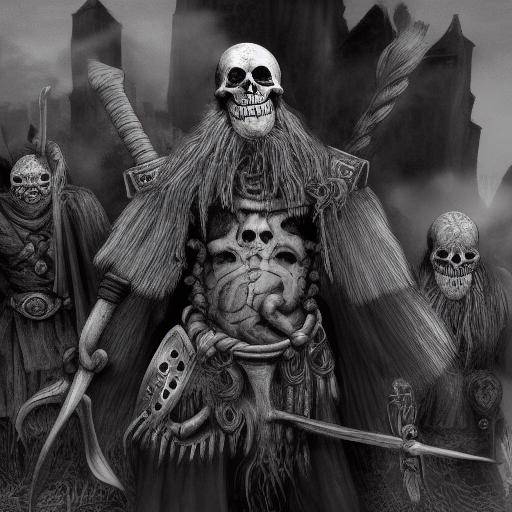
Them Draugr, mythical beings of Nordic mythology, evoke an aura of mystery and danger. These undead Vikings, whose souls and bodies are kept in a state of non-life, have fascinated generations for centuries. Join us on this journey as we explore the fascinating history, legends and meaning behind the Draugr, their relationship with the Vikings and the connection with the ancient Nordic tombs. In addition, discover how these beings have inspired stories, legends and left their mark on popular culture. Prepare to immerse yourself in the enigmatic world of the Draugr.
Introduction: The Mystery of the Draugr
Them draugr, known to be non-dead Vikings, are beings that continue to physically inhabit the world of the living while they are unlinked from their souls. It is believed that the tombs and territories in which they lived, protecting their treasures and carrying out revenge on those who trouble their eternal rest. Mention of the _draugr_Vikings and tombs awaken interest and curiosity, so it is important to immerse ourselves in this fascinating theme from the beginning.
History and Background: The Legacy of the Draugr
To fully understand the _draugr_We must go into Nordic history and mythology. The Vikings, a group feared and venerated in history, fervently believed in life after death and in the preservation of identity even in the beyond. This belief gave rise to the stories of the _draugr_That goes back centuries.
Them draugr They were originally human beings, often warriors or prominent leaders, who during their lives exhibited outstanding courage and skill. In death, it was believed that they maintained supernatural characteristics, including inhuman force, limited immortality and power over natural elements.
These viking non-dead, often buried with their most precious belongings, became a source of fear and respect. His presence in ancient graves has inspired stories of courage, deceit and epic battles. Viking society, which gave great importance to funeral customs and wealth buried with the deceased, preserved these legends over the centuries, contributing to the persistence of the figure of the draugr in popular culture.
The Draugr's Ingenio: Eternal Watchers of Their Treasures
The creation of these demonic creatures has not only served to inculcate the fear of the Vikings, but also as a living reminder of the wealth and power attributed to them and the importance of respecting the deceased. The Draugr became a fundamental element of the Nordic funeral tradition, keeping alive both the memory of the deceased and their influence on the daily lives of the living.
Today, the Draugr, Vikings and tombs continue to capture the imagination of writers, filmmakers and mittology enthusiasts alike. His stories continue to reinvent and transmit to new generations, demonstrating that the Draugr legacy remains firm over time.
Conclusion
The legacy of the Draugr, Vikings and tombs continues to influence popular culture and to keep alive the fascination with the mystical and the supernatural. Over the centuries, they have proved to be much more than creatures of an ancient mythology; they have forged a legacy that lasts until today. Who knows what new interpretations and amazing stories will stop us in the future? In exploring these mythical figures, we not only discover a rich cultural tradition, but also embark on a journey towards an intriguing and mysterious past that continues to capture our imagination.
Frequently asked questions
What's the Draugr story?
Them Draugr they have their roots in the Nordic mythology, where they are described as non-violent Vikings that protect their graves and treasures. These creatures have been an integral part of Viking culture, transmitting over the centuries through stories and legends.
What is the significance of the Draugr in Nordic mythology?
Them Draugr represent the connection between the world of the living and the beyond. They are often attributed supernatural powers, such as incredible strength and the ability to control natural elements. They are regarded as guardians of their graves and treasures, and their presence inspires fear and respect.
What is the relationship between the Draugr and the Vikings?
Them Draugr they are considered as non-dead Vikings, as they are supposed to be leaders or warriors featured in life that maintain supernatural characteristics in death. The figure of the Draugr reflects the importance of courage and skill in Viking society, as well as the valuation of life after death.
Where are the references to the Draugr in popular culture?
Them Draugr have appeared in numerous fictional works, including literature, cinema, video games and other forms of entertainment. His presence in popular culture shows the persistence of his legacy in contemporary imagination, keeping his influence alive through various artistic interpretations.
What similarities do the Draugr have with other mythical figures of different cultures?
Them Draugr They share similarities with other mythical figures in different cultures that represent life after death, treasure protection and supernatural influence on the living. These similarities reflect the universality of certain subjects in mythological traditions around the world.
What is the importance of preserving the stories of the Draugr and Vikings?
Preserving the Stories of the Draugr and Vikings is crucial to keeping alive a significant part of Nordic culture and mythology. These narratives provide a unique vision of the worldview and beliefs of ancient societies, enriching our understanding of the past and its influences in the present.
In short, the influence of the Draugr Vikings transcends time and space, continuing its legacy in popular culture and maintaining its place as enigmatic figures in Nordic mythology. The meaning and symbolism inherently linked to these non-dead beings reaffirm their relevance today and their ability to astound and fascinate those who venture to explore their mysteries.
